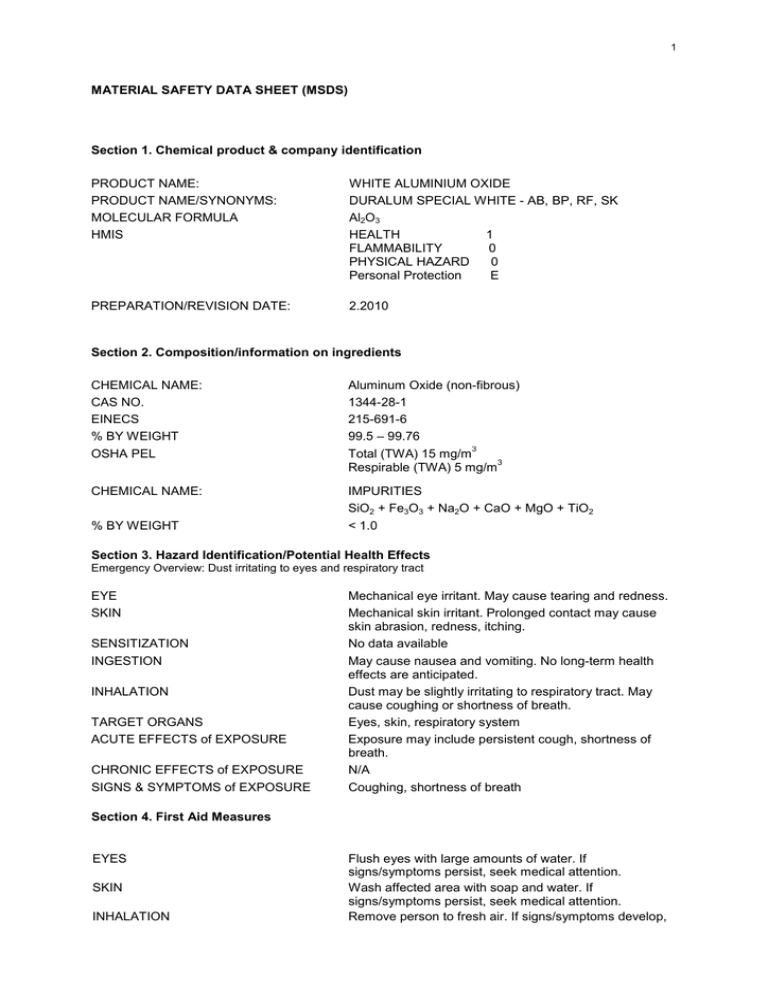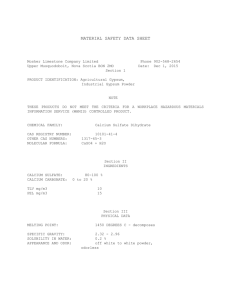MATERIAL SAFETY DATA SHEET
advertisement

1 MATERIAL SAFETY DATA SHEET (MSDS) Section 1. Chemical product & company identification PRODUCT NAME: PRODUCT NAME/SYNONYMS: MOLECULAR FORMULA HMIS WHITE ALUMINIUM OXIDE DURALUM SPECIAL WHITE - AB, BP, RF, SK Al2O3 HEALTH 1 FLAMMABILITY 0 PHYSICAL HAZARD 0 Personal Protection E PREPARATION/REVISION DATE: 2.2010 Section 2. Composition/information on ingredients CHEMICAL NAME: CAS NO. EINECS % BY WEIGHT OSHA PEL Aluminum Oxide (non-fibrous) 1344-28-1 215-691-6 99.5 – 99.76 3 Total (TWA) 15 mg/m 3 Respirable (TWA) 5 mg/m CHEMICAL NAME: IMPURITIES SiO2 + Fe3O3 + Na2O + CaO + MgO + TiO2 < 1.0 % BY WEIGHT Section 3. Hazard Identification/Potential Health Effects Emergency Overview: Dust irritating to eyes and respiratory tract EYE SKIN SENSITIZATION INGESTION INHALATION TARGET ORGANS ACUTE EFFECTS of EXPOSURE CHRONIC EFFECTS of EXPOSURE SIGNS & SYMPTOMS of EXPOSURE Mechanical eye irritant. May cause tearing and redness. Mechanical skin irritant. Prolonged contact may cause skin abrasion, redness, itching. No data available May cause nausea and vomiting. No long-term health effects are anticipated. Dust may be slightly irritating to respiratory tract. May cause coughing or shortness of breath. Eyes, skin, respiratory system Exposure may include persistent cough, shortness of breath. N/A Coughing, shortness of breath Section 4. First Aid Measures EYES SKIN INHALATION Flush eyes with large amounts of water. If signs/symptoms persist, seek medical attention. Wash affected area with soap and water. If signs/symptoms persist, seek medical attention. Remove person to fresh air. If signs/symptoms develop, 2 INGESTION seek medical attention. Ingestion is an unlikely route of exposure. Leave decision to induce vomiting to qualified medical personnel, since particles may be aspirated into the lungs. Seek immediate medical attention. Section 5. Fire Fighting Measures COMBUSTIBLE PROPERTIES EXTINGUISHING MEDIA None Extinguisher suitable for ordinary combustible materials. Class A extinguishing agents. SPECIAL FIRE FIGHTING PROCEDURES In fire conditions, fire-fighters should wear appropriate respiratory protection and full protective gear. FIRE & EXPLOSION HAZARDS Not applicable. None inherent in this product. Section 6. Accidental Release Measures PERSONAL SAFETY PRECAUTIONS ENVIRONMENTAL PRECAUTIONS CLEANUP MEASURES Avoid creating dust. Avoid contact with skin and eyes. Use with adequate ventilation. Ensure material is properly disposed of. Collect spilled material mechanically and place in a suitable, compatible, properly labeled container. Avoid creating any dust. Ensure adequate ventilation and dispose of material in accordance with all applicable local, state and federal laws. Section 7. Handling & Storage HANDLING STORAGE Avoid contact with skin and eyes. Wash hands before eating. Prevent the formation of dust. Handle with adequate ventilation. Normal Storage: Store in the original container in a cool, dry well ventilated area. Keep containers tightly sealed. Section 8. Handling & Storage ENGINEERING CONTROLS HYGIENIC MEASURES RESPIRATORY PROTECTION EYE PROTECTION SKIN PROTECTION Provide sufficient mechanical ventilation to reduce airborne concentrations and minimize exposure. Maintain employee exposure below applicable permissible exposure limits. Do not inhale dust/smoke/mist. Avoid contact with skin and eyes. Wash hands before eating. Avoid breathing dust. Assess exposure concentrations of all materials involved in the workplace. If concentrations exceed the exposure limits listed in Section 2, Exposure Guidelines, or irritation or other symptoms are experienced, follow the OSHA respirator regulations found in 29 CFR 1910.134 or European Standard EN 149. Use a NIOSH/MSHA or European Standard 149 approved respirator. Avoid eye contact. To minimize the risk of injury to eyes, always wear appropriate protective safety glasses or chemical safety goggles. Avoid skin contact. Wear appropriate protective clothing to minimize risk of injury to skin from contact with dust or physical abrasion. 3 Section 9. Physical & Chemical Properties FORMULA PHYSICAL STATE BOILING POINT MELTING POINT pH at 20° APPEARANCE ODOR FLASH POINT DECOMPOSITION TEMPERATURE VAPOR PRESSURE VAPOR DENSITY EXPLOSIVE PROPERTIES SOLUBILITY OXIDIZING PROPERTIES SPECIFIC GRAVITY BULK DENSITY Al2O3 Solid-granular N/A 2100° C N/A White Odorless N/A N/A N/A N/A None Insoluble N/A 3.6 N/A Section 10. Stability & Reactivity THERMAL DECOMPOSITION INCOMPATIBILITY CONDITIONS TO AVOID HAZARDOUS DECOMPOSITION PRODUCTS DANGEROUS REACTIONS HAZARDOUS POLYMERIZATION N/A N/A None known None expected None known Will not occur Section 11. Toxological Information CAS # 1344-28-1 COMPONENT ANALYSIS LD50/LC50 CARCINOGENICITY EPIDEMIOLOGY TERATOGENICITY NEUROTOXICITY MUTAGENICITY REPRODUCTIVE EFFECTS Data Not Available Section 12. Ecological Information ECOTOXICITY Not Available Section 13. Disposal Considerations Solid or chemical waste generators must determine whether a discarded waste is classified as a hazardous waste. U.S. EPA guidelines for the classification determination are listed in 40 CFR Parts 261.3. Additionally, waste generators must consult state and local waste regulations to ensure complete and accurate classification. 4 Section 14. Transportation Information DOT IMDG ACAO/IATA EU (ADR, RID) This product is not regulated by USDOT as a Hazardous Material (49 CFR 172.101). No UN code assigned. No placard required for transportation. Not regulated as a Hazardous Material. Not regulated as a Hazardous Material. Not regulated as a Hazardous Material. Section 15. Regulatory Information TSCA RCRA CERCLA SARA Aluminum Oxide is listed on the TSCA inventory under CAS# 1344-28-1 Aluminum Oxide is not classified as a hazardous material under RCRA or its regulations, 40 CFR 261. Aluminum Oxide is not classified as a hazardous substance under CERCLA regulations, 40 CFR 302. Aluminum Oxide is not an extremely hazardous substance in Section 302 and is not a toxic chemical subject to the requirements of 313. The information above is believed to be accurate and represents the best information currently available to ceroglass. However, ceroglass makes no warranty of merchantability or any other warranty, express or implied, with respect to such information, and assumes no liability resulting from its use. Users should make their own investigations to determine the suitability of the information for their particular purposes. In no event shall ceroglass be liable for any claims, losses, or damages of any third party or for lost profits or any special, indirect, incidental, consequential or exemplary damages, howsoever arising, even if ceroglass has been advised of the possibility of such damages.




